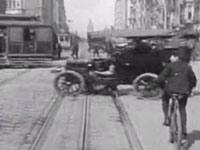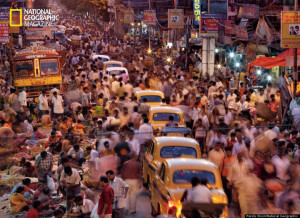Video of a chaotic but functional San Fran street from 1906 – lesson about game AI agents, social commentary on governments, or just a sign my coffee is a little too strong on this 9:35am Sunday morning?
Look at all the pedestrians, trams, hose-carriages, cars and bicycles all going where they please without any structure or traffic control to speak of. Yet no one is getting hit or blocked, no terrible delays seem to be occuring, and everyone is geting where they need to. For all intents and purposes, this chaotic system – or lackthereof – works!

The trams follow pretty simple nav paths. The horse-carriage squeezes between two carts, clearly calculating it as the most optimal route to their target. The bicycle stops when his path suddenly becomes obstructed by a car. And the pedestrians – they cleverly zig-zag around all the others scaling their “distance radius” with the size of the obstacles, brushing against other people but keeping further away from cars.
“That’s some damn good AI there!” is what I initially thought. But there is no global AI controller and no convenient navgraph – or, if there is one, it unpredictably changes every 3 seconds. But what we have instead is a bunch of really clever and responsive agents.

There’s a lot of good technical reasons why generalizing or simulating shared AI is necessary, particularly in big simulated environments of GTA or SimCity. Processing power limitations aside, you often end up with AI agents doing something “stupid,” getting stuck or blocking each other endlessly. Hence navgraphs and the such. Yet none of that happens in the video, and the end result feels far more lively and… organic?
It’s also fun to look at it as a very simple social model as well – no traffic rules, no “government” telling the people how to drive down the road, just trusting the individuals to make the right choices, something we seem to panically fear in contemporary times. But it works here!
Of course that’s a tremendous generalization and to call comparing a busy street to the governing of entire society “simplification” is understating it by tons, miles, moles, or whatever your favorite unit of measurement is. There’s so many other problems a street doesn’t need to deal with, from resources to crime. But maybe, just maybe, there is a little nugget of truth about what properly educating the individuals and providing the tools to “figure things for their own” can do?
I’m not really trying to have a clear point or make any arguments here, just randomly throwing things out there to ponder.
Or perhaps my morning coffee really is a tad bit too strong today…